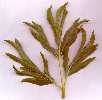Forms of Paeonia peregrina, treatet here separately
listed by:
It is also probable, but not definitely established, that Peter Barr of London may have made species crosses on Paeonia officinalis (for he introduced some fine seedlings under the names Ceres, Charmer, Otto Froebel, and Sunbeam) and on Paeonia arietina, from which a superior cultivar was obtained which he named Northern Glory. Our geneticists, cytologists, and morphologists may some day shed light on the parentage of these plants, but whatever records Barr may have kept were lost in a fire in his office long after his death. We know little or nothing of the means by which these hybrids [if they were really hybrids] were produced.
Kortmann (1998)
peregrina 'Otto Fröbel' (Otto Froebel') (syn. 'Sunshine') (Barr, 1898) Bloemen lichtend oranjerood tot zalmkleurig rood (RHS CC 53B, Red Group), klein, enkel; meeldraden geel, talrijk; hoogte 50 cm. Deze sterk op P. peregrina 'Fire King' gelijkende cultivar is door de schitterende bloemkleur niet uit het sortiment weg te denken. De plant is wel iets gevoelig voor Botrytis. De meerderheid van de keuringscommissie vond desondanks een beoordeling met één waardester gerechtvaardigd. Deze pioen is veel gebruikt om te kruisen met cultivars uit de Lactiflora Groep.
LOBATA OTTO FROEBELI (Simple). Colons rouge orangé nettement teinté de saumon. Plante très florifère. Excellente. H. 0,80 m. Précoce.
LOBATA SUNSHINE (Simple). Voilà incontestablement la meilleure de toutes les Pivoines issues d'espèces botaniques. Son extraordinaire coloris rouge orangé, la forme globuleuse de son bouton, le contraste de coloris avec les étamines une fois la fleur épanouie, en font une des variétés les plus recherchées. H. 0,80 m.
- complete set:
outer side
inner side
Upper surface/Oberseite
Lower surface/Unterseite
- Autumn/Herbst


Romania Banat
Jugoslavia
? Heinze2
peregrina/officinalis cultivar
Die genaue Zuordnung von Staudenpfingstrosen dieser Gruppe ist insofern problematisch, daß viele im 20. Jahrhundert als „Paeonia officinalis“-Kultivare bezeichnete Sorten eigentlich Abkömmlinge von Paeonia peregrina sind. Bis in die 1930er Jahre hießen auch die Peregrinas alle Paeonia officinalis. Ich bezweifle, daß ein Großteil dieser Gruppe irgendetwas mit Paeonia officinalis zu tun hat, angefangen bei der allseits bekannten Bauernpfingstrose „Officinalis Rubra Plena“, die entweder ein Kultivar von Paeonia peregrina ist oder (wahrscheinlicher) eine Hybride aus Paeonia peregrina und einer anderen Wildart, vielleicht Paeonia officinalis. Um dieses Zuordnungsproblem zu umgehen, hier die Gruppe „p/o“: Sorten, die im Wuchs, Blütenstellung, Laub und Farbe Paeonia peregrina ähneln bzw. Paeonia 'Officinalis Rubra Plena'. Die Zuordnung zu den Hybriden erfolgt wegen der bestehenden Unsicherheiten nicht.
Peonies, The Manual of the American Peony Society, edited by James Boyd © 1928 American Peony Society:
P. officinalis. Southern Europe. This species has been cultivated in European gardens for centuries, and has given rise to a number of. brilliant and lovely varieties. There is much confusion regarding those which are to be traced back to P. officinalis and those derived from P. paradoxa.
Vilmorin ("Fleurs de Pleine Terre") separates two groups under these two specific names; and he states that those derived from P. paradoxa are easily distinguished by the glaucescence (bluish greenness) of the foliage. Unfortunately, Vilmorin does not include in nis list by any means all of the varieties which are, or have been, in commerce.
Since these forms when offered in nurserymen's lists are usually grouped all together under P. officinalis, I have listed them all here, making a separate group of those which, according to Vilmorin, should be referred to P. paradoxa.
A further complication arises from the fact that several varieties have been produced from P. lobata. This is itself to be considered as a variety of P. officinalis, and it is not always possible in the case of named varieties to say whether they should be referred to P. lobata or to the broader species P. officinalis.
Varieties probably referable to P.officinalis:
alba mutabilis
alba plena
atrorubra plena
anemoneflora
blanda
carnea plena. Syn. alba mutabilis
carnescens
Ceres
Charmer
Eclair. Syn. alba mutabilis
Fire King
fulgens
incarnata plena. Syn. alba mutabilis
Lize van Veen. Sport from P. rosea superba, which has been recently introduced into commerce in Holland.
lobata : Otto Froebel, Sunbeam
maxima rosea plena
Ophia
Oriflamme
purpurea plena
rosea (single)
rosea pallida plena. Syn. alba mutabilis
rosea plena
rosea superba plena (rated 8.2 in symposium, 1925)
rubra plena (rated 8.6 in symposium, 1925)
Sabini
sanguinea plena
splendens
striata elegans
The Sultan























